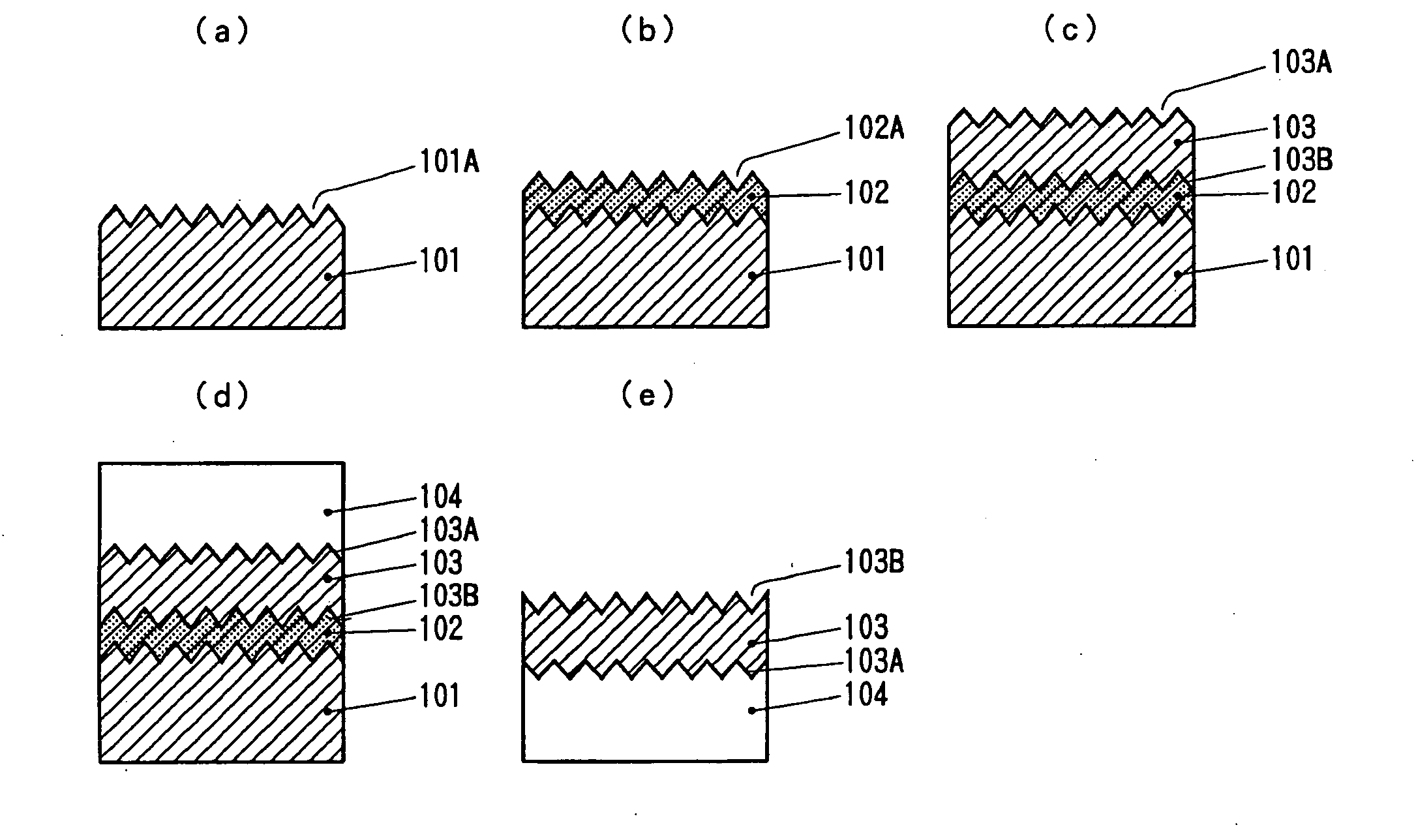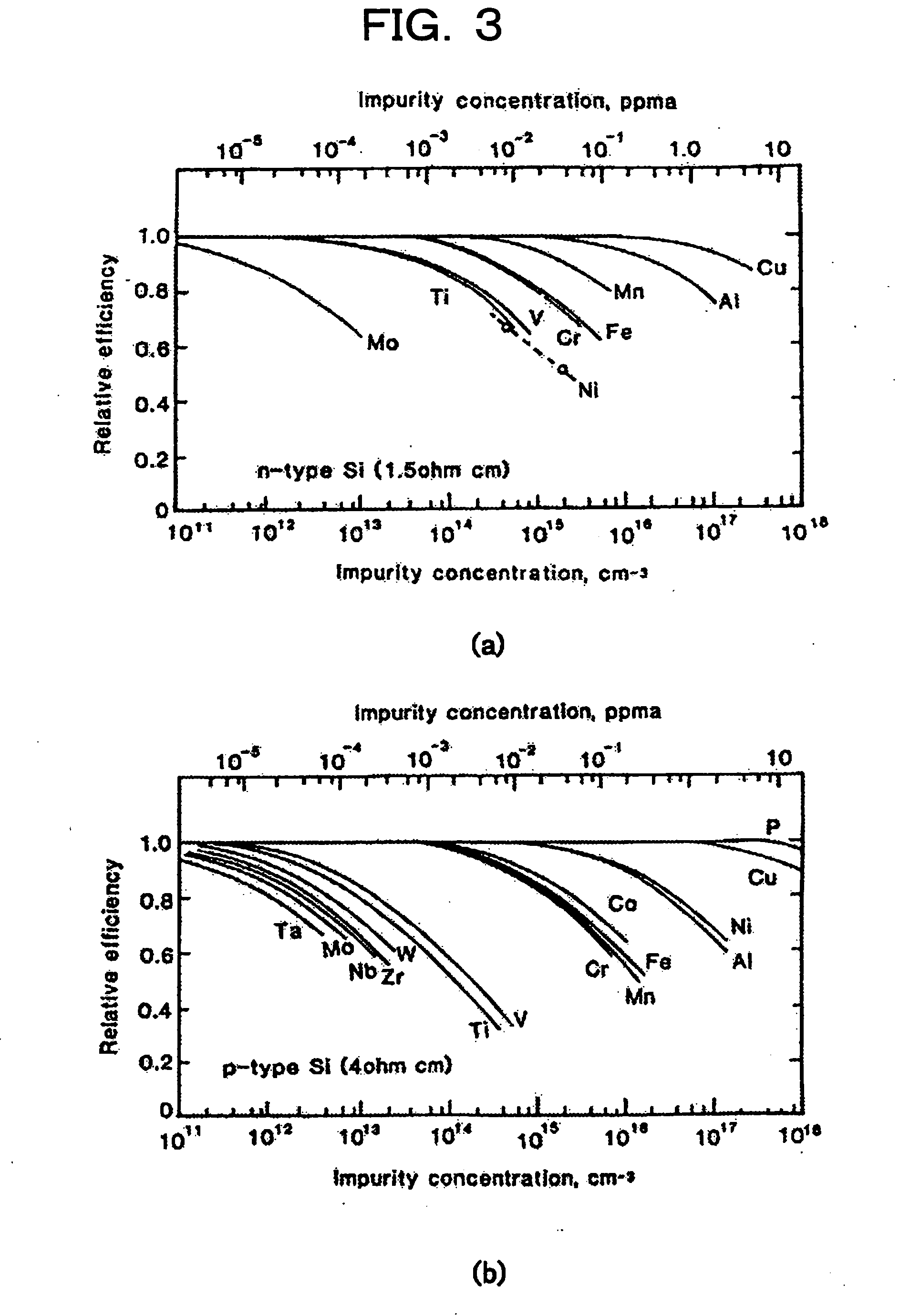Process for Producing Monocrystal Thin Film and Monocrystal Thin Film Device
- Summary
- Abstract
- Description
- Claims
- Application Information
AI Technical Summary
Benefits of technology
Problems solved by technology
Method used
Image
Examples
example 1
[0167]FIG. 10 includes cross-sectional views showing manufacturing steps of Example 1 according to the present invention.
[0168](1) First, as shown in FIG. 10(a), a monocrystalline silicon substrate (such as 500 μm thick) 71 is prepared.
[0169]This monocrystalline silicon substrate 71 has a flat upper surface since a monocrystalline silicon sacrificial film, which will be described later, is to be epitaxially-grown.
[0170](2) Next, as shown in FIG. 10(b), on the monocrystalline silicon substrate 71, by a sputter-deposition method with substrate heating, silicon containing crystal defects is epitaxially-grown in an atmosphere containing small amounts of oxygen and water vapor. That is, a monocrystalline silicon sacrificial film (such as 0.1 to 1 μm thick) 72 containing crystal defects is formed. This monocrystalline silicon sacrificial film 72 can be easily and precisely removed by etching, as described later.
[0171](3) Next, as shown in FIG. 10(c), on the monocrystalline silicon sacrifi...
example 2
[0175]FIG. 12 includes cross-sectional views showing manufacturing steps of Example 2 according to the present invention.
[0176](1) First, as shown in FIG. 12(a), a monocrystalline silicon substrate (such as 500 μm thick) 81 is prepared.
[0177]This monocrystalline silicon substrate 81 has a flat upper surface since a monocrystalline silicon sacrificial film, which will be described later, is to be epitaxially-grown.
[0178](2) Next, as shown in FIG. 12(b), on the monocrystalline silicon substrate 81, by a sputter-deposition method with substrate heating, silicon containing crystal defects is epitaxially-grown in an atmosphere containing small amounts of oxygen and water vapor. That is, a monocrystalline silicon sacrificial film (such as 0.1 to 1 μm thick) 82 is formed. This monocrystalline silicon sacrificial film 82 can be easily and precisely removed by etching, as described later.
[0179](3) Next, as shown in FIG. 12(c), on the monocrystalline silicon sacrificial film 82, monocrystalli...
example 3
[0183]FIG. 13 includes cross-sectional views showing manufacturing steps of a monocrystalline thin film of Example 3 according to the present invention.
[0184]This example is the same as Examples 1 and 2 except that holes 91A are formed in a monodrystalline silicon substrate 91 at intervals. That is,
[0185](1) first, as shown in FIG. 13(a), the monocrystalline silicon substrate 91 is prepared in which the holes 91A are provided at intervals.
[0186]An optical microscope photograph of a plane surface of the monocrystalline silicon substrate 91 is shown FIG. 14 in which the holes 91A of 100 μm in diameter are formed at 1 mm intervals by photolithography and selective etching.
[0187](2) Next, as shown in FIG. 13(b), on the monocrystalline silicon substrate 91, by a sputter-deposition method with substrate heating, silicon containing defects is epitaxially-grown in an atmosphere containing small amounts of oxygen and water vapor. That is, a monocrystalline silicon sacrificial film 92 is form...
PUM
| Property | Measurement | Unit |
|---|---|---|
| Temperature | aaaaa | aaaaa |
| Temperature | aaaaa | aaaaa |
| Thickness | aaaaa | aaaaa |
Abstract
Description
Claims
Application Information
 Login to View More
Login to View More - R&D
- Intellectual Property
- Life Sciences
- Materials
- Tech Scout
- Unparalleled Data Quality
- Higher Quality Content
- 60% Fewer Hallucinations
Browse by: Latest US Patents, China's latest patents, Technical Efficacy Thesaurus, Application Domain, Technology Topic, Popular Technical Reports.
© 2025 PatSnap. All rights reserved.Legal|Privacy policy|Modern Slavery Act Transparency Statement|Sitemap|About US| Contact US: help@patsnap.com



